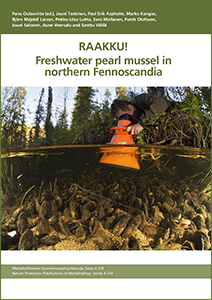Raakku! – Freshwater pearl mussel in northern Fennoscandia
The freshwater pearl mussel (Margaritifera margaritifera) is a species classified as endangered (EN), and protected under Annexes II and V of the Habitats Directive, and under the Nature Conservation Act. It is an indicator species, that tells about the natural state of the river ecosystem. It is also an umbrella species that provides a beneficial, clean habitat for a number of other species, including the salmon and brown trout that are the hosts of its larvae, known as glochidia.
Freshwater pearl mussel populations in Fennoscandia were mapped in two previous EU-funded Interreg projects in the 2000s. This Finnish-Norwegian-Swedish project expanded and deepened the co-operation and expert network created in the previous projects by extending the measures not only to mapping, but to concrete action to protect the populations. This was implemented by producing updated information about the status and genetic structure of freshwater mussel populations, and by charting the reasons for the decline of populations, and ways and methods for maintaining and restoring non-recruiting populations, and on the other hand develop cost-efficient means to discover previously unknown freshwater mussel populations. The project’s communication activities aimed at distributing information about how the protection of freshwater pearl mussel waters should be taken into consideration e.g. in forestry or other activities that influence the river environment.
Field work during the project was undertaken in a total of 187 different rivers in 15 main river basins. In the course of the project, 12 new freshwater pearl mussel populations were discovered. Moreover, it was proven that freshwater pearl mussel glochidia can be detected with the naked eye in juvenile brown trout in connection with electricfishing. This method was used as a new search tool in northern rivers. Updated information about population status was acquired from 30 rivers, 21 in Finland, 4 in Sweden and 5 in Norway. Unfortunately, the status of populations proved to be worse than expected: mussel recruitment was estimated as sustainable in only 1-3 populations in the long term.
The genetic structure of populations was studied in 21 rivers. Based on the results, the population were classified according to their viability and protection status, and a proposal was made concerning the rivers that should be included in the monitoring programme of freshwater pearl mussel waters in Finland. Host fish experiments revealed the segregation of freshwater pearl mussel populations into those dependent on salmon or brown trout in previous salmon rivers vs. brown trout brooks. Cultivation experiments proved that it is possible to cultivate freshwater pearl mussel glochidia in laboratory conditions, while co-operation with a fish farm proved that it is possible to infest glochidia to large numbers of host fish for potential planting purposes.
In addition to this report, the project produced a booklet on the protection of freshwater pearl mussel rivers. The booklet is intended for forestry operators in particular, but is a useful tool also for the authorities responsible for freshwater pearl mussel protection, Nature Inventory Officers and hikers.
